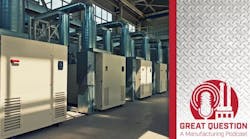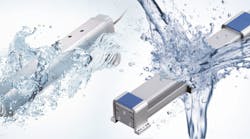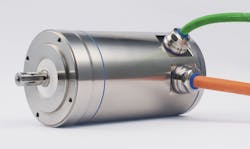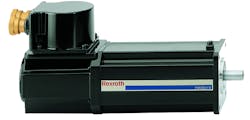In the last few years, the use of electric servo technology has expanded rapidly into applications that have traditionally been deprived of the benefits of high-performance motion control. Specifically, this includes applications involving harsh environments, high torque-to-volume ratios, or sometimes both.
Servo technology is not considered new when it comes to machine design and motion control. However, deploying it in unconventional applications is an area where process gains can be realized. The key is using specialty servomotors that will operate safely and reliably in extreme environments. In addition, the need for the end solution to fit into the available envelope of the machine is driving the use of electromechanical actuators with integrated servomotors.
Until recently, the challenge of using servos in these applications was based on the requirement for the OEM or end user to use a servo drive platform unique to the specialty servomotor or electro-mechanical actuator that is appropriate for the application.
Application Requirements
Many different processes and environments with extreme conditions, the likes of which are found in food and beverage, pharmaceutical, and oil and gas markets, can greatly benefit from servo technology.
Wash-down processes are a common component of food and beverage applications and typically involve caustic solutions that create a corrosive environment. Standard servomotors do not hold up well in these environments, forcing a compromise between machine performance, reliability, and food safety. The painted surfaces eventually chip and allow for corrosion to begin. Standard servomotors also have nooks and crannies that hold on to food particles during the wash-down process, which leads to bacteria growth. Many OEMs are turning to hygienic-design, stainless-steel motors to withstand the harsh processes and ensure complete sanitization.
The INMOCO194 is a stainless-steel servomotor. Stainless-steel servomotors offer a hygienic design, can withstand the harsh processes, offer complete sanitization, and can also withstand severe weather and corrosion.
Replacing pneumatic actuators with electromechanical devices is also becoming more popular in food and beverage to achieve gains in energy efficiency, food safety, and improved control. This trend is promoting the use of servomotors that can withstand these environments.
Servomotors are also being used in harsh environments to replace hydraulic actuators. Equipment used in oil and gas applications often operate in areas with a high potential for explosions. Hydraulic actuators are used because they are inherently explosion-proof. However, a certain amount of control is sacrificed when implementing hydraulics in these solutions. The substitution of electric, explosion-proof servomotors that can perform in harsh environments allows the user more refined and accurate control while maintaining the safety of their process. With certified explosion protection, servomotors are applicable in processes with a presence of explosive fumes like the ones found in painting or oil and gas.
In addition to environmental drivers, actuation requiring high torque-to-volume ratios is driving the need for electromechanical actuators with integrated servomotors. The benefit of these electromechanical actuators is their ability to compact a machine design by integrating the servomotor with the mechanics. Building the servomotor into the mechanics condenses the piece of equipment needed for the process.
An example of this application is a situation where an OEM needs a servo-controlled rotary actuator but has a limited space. In the past, the OEM would have to use a servomotor bolted to a gearbox, which would increase the overall volume. Now OEMs can use off-the-shelf integrated servomotor gearboxes that provide rotary actuation that fits into a small space. Integrated servomotor gearboxes are also ideal for rigid, high-accuracy applications that previously had limited solutions.
Another example can be found in the agriculture industry. Traditional factory automation applications are making their way into the fields as companies deal with labor shortages. Elements of motion control on mobile equipment, such as harvesting machines, can be subjected to extreme outdoor environments and must fit in limited spaces. Vision-controlled pick-and-place requires a high level of motion control. Electromechanical actuators provide that level of control while also maintaining the same safety measures as a machine using hydraulics. With the use of stainless-steel servomotors, they can also withstand the weather and corrosion of the harvesting process.
Why Now?
If servo technology comes with process safety and optimization, why are solutions just now being adopted on a large scale in these applications?
The simplest explanation would be to compare the relationship between servo drives and servomotors to that of motion or logic controllers and servo drives. Open digital communication standards such as EtherCat, Ethernet IP, and ProfiNet made it very easy to use the most appropriate machine-control platform with the best performing servo system. However, the digital communication between the servomotor and drive remained proprietary, therefore locking consumers into a motor and drive package from one supplier. Motor feedback standardization is changing that.
Standardization of digital motor feedback has driven the adoption rate of using third-party servomotors by many servo drive manufacturers. Tools for drive parameterization to make third-party motors plug-and-play as well as supplying cable sets make it easier for OEMs and end users to use third-party servomotors with the servo drive platform they are comfortable with.
With the understanding of the technology comes the understanding of what end users need from manufacturers to make the solutions work best for their processes. Previously, users would not have options when choosing a specialized servomotor to accompany their preferred drive platform. This has led to an increase in standardization among manufacturers, thus expanding the options for users to choose from when designing with servo technology. Certain markets are still adapting to this change, however. Some Japanese manufacturers of servo motors still tend to have closed applications that limit a user to their products alone, many American and European manufacturers provide compatible components. This ability to pick and choose the elements that are best for the user’s process has made a large contribution to the adoption of the technology.
Choosing the Right Solution
When implementing third-party servomotors, there are some important factors to consider. Probably the most crucial of them is finding a manufacturer whose servomotor is compatible with a wide array of servo drives. This is essential in making sure the change can be made without incurring significant engineering and startup time. This harkens back to motor feedback standardization and having the opportunity to choose the best solution for every application, because the whole idea is to create an open architecture between servo drives and motors. Users should also search for manufacturers that provide support for their technology. For example, if an OEM is using a stainless-steel servomotor with a drive from a separate manufacturer, there are some companies that will provide the parameters and tools to help the user set up the motor and drive and make them work together.
This MKE motor is an explosion-proof rated servomotor. They can perform in harsh environments that allow the user more refined and accurate control while maintaining the safety of their process.
The end game with servo technology in the world of motion control is putting the elements where they haven’t gone before. Though there has been widespread use of servomotors and drives, they are just now starting to venture into harsh environments and processes. The market is now allowing users to implement the solutions with a servo drive platform they are comfortable and familiar with. Understanding this increase of adoption is important to seeing the benefits and changes these technologies can bring to processes. With costs falling and availability of integration among manufacturers rising, industries will see an increase in the future use of extreme environment servo motors and actuators.












